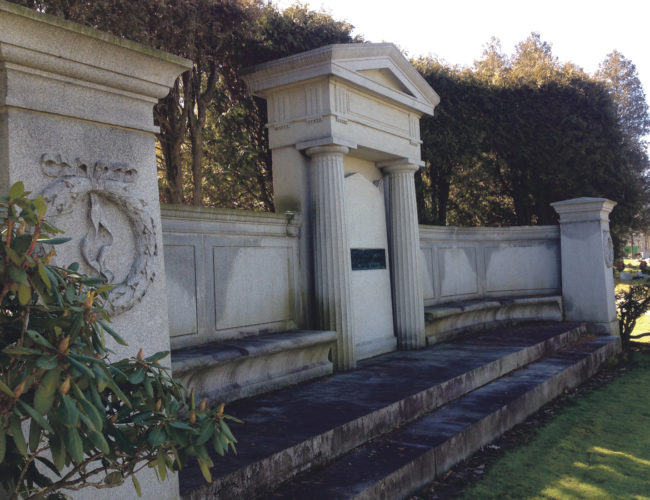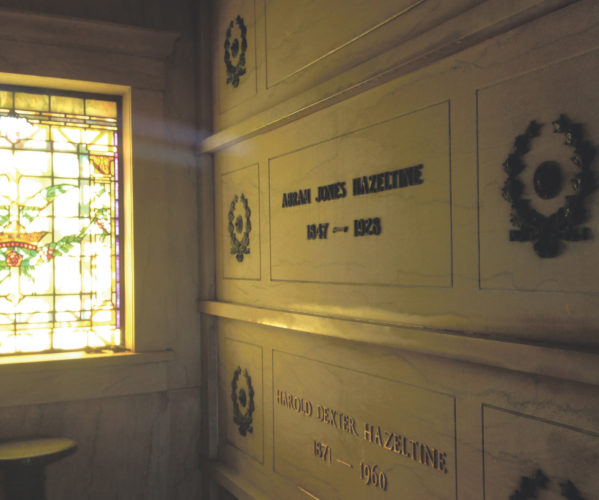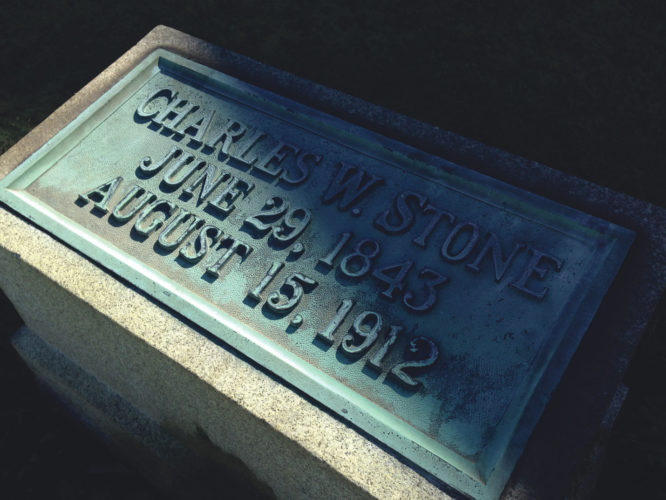Many Uses; Enduring elegance
A.J. Hazeltine house on Warren’s west side one of county’s sites on National Register of Historic Places
It started as a private residence for one of Warren’s leading citizens.
Then it became the home of the American Legion.
Then a museum recognizing another of Warren’s leading citizens.
Then a private residence again.
It’s got several names – the A.J. Hazeltine House, the America Legion Home and the Honorable Charles Warren Stone Museum.
Whatever you want to call it, the address is 710 Pennsylvania West and it is one of 11 sites in Warren County to be included on the National Register of Historic Places, first included on the list in 1976.

Stone, Pennsylvania’s second Lieutenant Governor.

This is the monument erected to Charles Warren Stone near his gravesite at Oakland Cemetery.

Below, the Hazeltine mausoleum where A.J. Hazeltine and his family have been buried. The mausoleum is located at Oakland Cemetery on Warren’s south side.

At left, a look into the mausoleum and the marker for A.J. Hazeltine’s resting place.

Much thanks to the Warren County Historical Society for sharing the photo of Hazeltine inset above.

Times Observer photos by Josh Cotton
Above, the A.J. Hazeltine house located on Pennsylvania Ave. W. in Warren

Inset are, below, a photo of his specific grave marker
The application submitted on behalf of the home for inclusion on the Register, prepared by the Warren County Historical Society, gives us the nuts and bolts of the building.
It’s three stories tall and done in “English Jacobean architecture.” The building is roughly 50 feet by 100 feet and built of brick and marble, the latter of whcih was imported from Vermont.
“Undoubtedly, the most striking feature of the interior is the large living room, twenty by thirty-four feet in size and extending the full width of the house with a fireplace at one end and a roundheaded double doorway giving on to the terrace at the other,” the application states. “The room is beamed and is paneled in dark oak to within 18 inches of the ceiling…. Across the front of the house on each side of a panelled and barrel-vaulted hallway are a small formal drawing room, classical in character… and opposite to this, a library with built-in bookcases and a fireplace set into a wide alcove… the woodwork of this room being mahogany and dark in finish.”
The dining room behind the living room, has similar sliding doors and is “panelled to a height of five feet in dark oak and, above that, is decorated with a landscapes which has recently (as of 1976) been cleaned and restored.”
Off the dining room is a solarium, “lighted on two sides by large windows and paved with tile.”
“Architecturally, the house is an excellent example of a large baronial residence in adaptive historical style, here (a) 16th Century English residence,” the application concludes, calling the house a “fine xample of the late Victorian tradition in Warren County.”
The home was originally built between 1905 and 1907 as a private residence – the purpose it currently serves – by A.J. Hazeltine.
The story of the man who built it is every bit as interesting as the home he built.
Abram Jones Hazeltine was born in Chautauqua County on August 30, 1847 to Dr. Abraham and Jane Morrison Hazeltine.
The obituary explains that his father “was a native of Wardsboro, Vt., and a graduate of Brattleboro Academy and Dartmouth College. He settled in Warren in 1820, where he was the first regular medical practicioner, and later became the first treasurer of the Warren school district.
The young Hazeltine’s first employment was at a general store in Busti, as he was unable to secure higher education after graduating from public school at the age of 14. When he was 18, he became a partner in the store before he jumped into governement, as deputy clerk for the Chautauqua County board of supervisors.
He moved to Warren in 1869 and his first job here was as a bookkeeper of the Piso Company, founded by his cousin, and best known for it’s cough medicine, “Piso’s Cure for Consumption.”
After just a few months with his counsin’s company, Hazeltine started working as a bookkeeper with the First National Bank before being promoted to teller and then cashier. He purchased the stock of the founder and first present in 1889 and was the chair of the board until he retired in 1923.
Hazeltine was also “president of the Warren Savings Bank from 1889 to January 1, 1928. He was associated with the bank since February 2, 1872.”
After serving as a councilman in the 1880s, he became the treasyrer for Warren Borough and served in that capacity for 40 years.
His business interests were much more varied than banking, though.
“Aside from his banking activities,” his obituary explains, “Mr. Hazeltine was associated with others in the acquisition of coal lands located in Kentucky and West Virginia and lumber lands located in Washington and Oregon. Locally, he was interested in the Warren Vaneer and Panel Company and the Conewango and Crescent Furniture companies. He was a director of the De Luxe Metal company, the Corry Brick and Tile Company… and of Abendroth Brothers, a manufacturing concern located at Port Chester, N.Y.”
His civic interests included work as a school director and as president of the YMCA.
In J.S. Schenck’s History of Warren County published in 1887, Hazeltine is listed as one who contirbuted to the Warren Library Association, then located at what is now the Struthers Library Theatre. He served as a burgess for Warren Borough in the 1880s and as a deacon of the First Baptist Church in the 1870s.
“His life was a record of personal advancement, public service, devotion to the community in which he lived nearly all his life, and a constantly widening range of personal and philanthropic friendships and financial acquaintanceships,” the obituary states.
That life also included a national appointment.
“In 1899, President William McKinley appointed Mr. Hazeltine to a member of the Assay Commission to examine the U.S. Mints,” his obituary states.
The Assay Commission was founded in 1792 with the purpose being that the commission would exmaine the coins coming from the mint to ensure they met all required guidleines. It was abolished in 1980.
He was one of the founders of the Pennsylvania Bankers’ Association.
Hazeltine married Hattie Davis of Busti in 1868 and they were married until her death in 1926. The couple had four surviving children.
Hazeltine is buied in the Hazeltine mausoleum in Oakland Cemetery.
After his death, the family sold the home to the American Legion.
“It was used by that organization for about 40 years and then sold to a local businessman for office space and rental income property,” the National Register application explains. “Late in 1975 the Warren County Commissioners purchased the property for use as a county museum, to be established and operated by the Warren County Historical Society.
That museum was known as the Honorable Charles Warren Stone Museum – Hazeltine and Stone were business associates and friends.
According to the Warren County Historical Society, Stone was born in 1843 in Massachusetts. Graduating college in 1843, Stone moved to Warren and became principal of the Union School and then the superintendent of schools in 1865.
After gaining entrance to the bar in 1867, Stone, in 1869, “was elected to the Pennsylvania House of Representatives and re-elected in 1870. Mr. Stone from Warren County and Mr. McJunkin of Venango County worked very hard to defeat a movement to split Warren and Venango Counties in half and make a new county. After two sessions he retired, but then in 1877 was elected to the State Senate. In 1878 he was elected Lieutenant Governor and served until 1883.”
Stone was just the second person to serve in that capacity.
“He was very much revered by both parties in the legislature and upon his retirement was presented with a gold watch and chain. Warren and Erie Counties tried to get him to run for Congress but he declined. In January, 1887, he was appointed Secretary of the Commonwealth of Pennsylvania.”
His home was on the corner of Liberty St. and Fifth Ave. in Warren and he was the first president of the Warren County Historical Society.
Executive Director Michelle Gray said that the WCHS sold the museum in 1996 and it has been a private residence since the sale.

